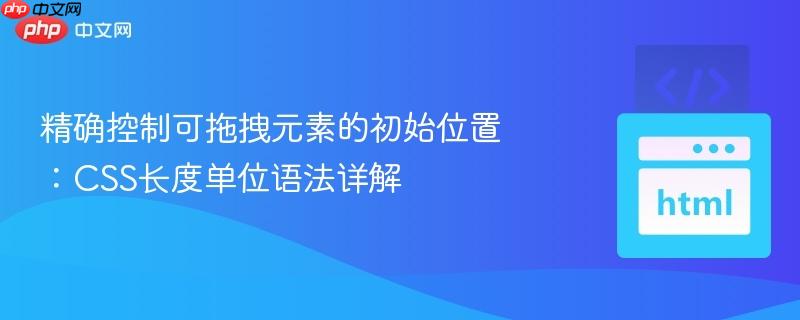
本教程详细探讨了在实现可拖拽图片功能时,如何正确设置元素的初始位置。核心问题在于css长度单位的语法规范,即数值与单位之间不允许存在空格。文章将通过分析常见错误、引用w3c标准,并提供正确的css代码示例,指导开发者避免因语法错误导致的定位失效,确保所有可拖拽元素都能按预期精确显示。
在Web开发中,创建可拖拽元素通常涉及HTML结构、CSS样式和JavaScript逻辑的协同工作。一个典型的可拖拽图片设置如下:
每个可拖拽元素通常包含一个主容器(例如,div.mydiv)和一个用于触发拖拽的头部区域(例如,div.mydivheader)。图片则嵌套在头部区域内。每个可拖拽元素通过唯一的id进行标识,以便进行特定的样式或行为控制。
<body>
<div class="mydiv">
<div class="mydivheader" id="one">
@@##@@
</div>
</div>
<div class="mydiv">
<div class="mydivheader" id="two">
@@##@@
</div>
</div>
<div class="mydiv">
<div class="mydivheader" id="three">
@@##@@
</div>
</div>
<div class="mydiv">
<div class="mydivheader" id="four">
@@##@@
</div>
</div>
<div class="mydiv">
<div class="mydivheader" id="five">
@@##@@
</div>
</div>
</body>为了使元素能够通过top和left属性进行定位和拖拽,其position属性必须设置为absolute。z-index属性用于控制元素在堆叠顺序上的层级,确保拖拽时元素能浮动在其他内容之上。cursor: move则能直观地提示用户该元素可拖拽。
.mydiv {
position: absolute;
z-index: 9;
}
.mydivheader {
padding: 10px;
cursor: move;
z-index: 10;
}JavaScript负责处理鼠标事件,计算元素的移动量,并实时更新元素的top和left样式。dragElement函数是实现拖拽的核心,它会监听mousedown事件以启动拖拽,在鼠标移动时更新元素位置,并在mouseup时停止拖拽。
立即学习“前端免费学习笔记(深入)”;
// Make the DIV element draggable:
var offset = 5; // 初始偏移量,但在CSS明确设置top/left时优先级较低
var mydivs = document.getElementsByClassName("mydiv");
for (var i = 0; i < mydivs.length; i++) {
dragElement(mydivs[i]);
// 这里的初始left设置可能会被CSS中的position:absolute和top/left覆盖
// mydivs[i].style.left = offset + "px";
// offset = offset + mydivs[i].offsetWidth + 5;
}
function dragElement(elmnt) {
var pos1 = 0, pos2 = 0, pos3 = 0, pos4 = 0;
if (elmnt.getElementsByClassName("mydivheader")[0]) {
/* If present, the header is where you move the DIV from:*/
elmnt.getElementsByClassName("mydivheader")[0].onmousedown = dragMouseDown;
} else {
/* Otherwise, move the DIV from anywhere inside the DIV:*/
elmnt.onmousedown = dragMouseDown;
}
function dragMouseDown(e) {
e = e || window.event;
e.preventDefault();
// Get the mouse cursor position at startup:
pos3 = e.clientX;
pos4 = e.clientY;
document.onmouseup = closeDragElement;
// Call a function whenever the cursor moves:
document.onmousemove = elementDrag;
}
function elementDrag(e) {
e = e || window.event;
e.preventDefault();
// Calculate the new cursor position:
pos1 = pos3 - e.clientX;
pos2 = pos4 - e.clientY;
pos3 = e.clientX;
pos4 = e.clientY;
// Set the element's new position:
elmnt.style.top = (elmnt.offsetTop - pos2) + "px";
elmnt.style.left = (elmnt.offsetLeft - pos1) + "px";
}
function closeDragElement() {
/* Stop moving when mouse button is released:*/
document.onmouseup = null;
document.onmousemove = null;
}
}注意事项: 尽管JavaScript中可能包含设置初始位置的逻辑(如上述代码中被注释掉的部分),但如果CSS中同时存在position: absolute和top/left属性,CSS的声明优先级通常会更高,尤其是在页面加载时首次渲染。因此,精确的初始定位应优先通过CSS实现。
在实际开发中,开发者可能会遇到部分可拖拽元素能够正确显示在指定初始位置,而另一些则无法生效的情况。例如,#one和#two元素按预期定位,但#three、#four和#five却未能。
/* 正确的定位示例 */
#one {
position: absolute;
top: 300px;
left: 1000px;
}
#two {
position: absolute;
top: 500px;
left: 400px;
}
/* 错误的定位示例 */
#three {
top: 459 px; /* 注意这里的空格 */
left: 100 px; /* 注意这里的空格 */
}
#four {
position: absolute;
top: 25 px; /* 注意这里的空格 */
left: 897 px; /* 注意这里的空格 */
}
#five {
position: absolute;
top: 25 px; /* 注意这里的空格 */
left: 174 px; /* 注意这里的空格 */
}从上述代码片段可以看出,#three、#four和#five的top和left属性值中,数值与单位px之间多了一个空格。这正是导致这些元素初始定位失效的根本原因。
根据W3C CSS规范(例如CSS2.1的“Lengths”章节),长度值(length)的格式定义为:一个数字(
这意味着:
当浏览器解析到top: 459 px;这样的声明时,由于其不符合CSS语法规则,该属性会被浏览器视为无效并忽略。结果是,元素无法获得预期的top和left值,从而无法在指定位置显示,而是回退到其默认的布局行为(例如,如果父元素是静态定位,则元素将按文档流排列)。
解决此问题的方法非常直接:移除所有长度值中数值与单位之间的空格。同时,为了确保top和left属性能够生效,强烈建议为所有需要通过这些属性进行绝对定位的元素明确声明position: absolute;。
/* 修正后的CSS代码 */
#three {
position: absolute; /* 确保定位生效 */
top: 459px;
left: 100px;
}
#four {
position: absolute;
top: 25px;
left: 897px;
}
#five {
position: absolute;
top: 25px;
left: 174px;
}通过上述修正,浏览器将能正确解析top和left属性,使所有可拖拽元素都能按照预期精确地显示在其初始位置。
实现可拖拽元素的精确初始定位,关键在于编写符合CSS规范的样式代码。尤其是在设置top和left等长度属性时,务必确保数值与单位之间没有多余的空格,并正确声明position属性。通过理解CSS语法规则并结合开发者工具进行调试,开发者可以有效避免常见的布局问题,确保Web应用的用户体验流畅且符合预期。正确的CSS语法是构建健壮、可维护Web界面的基石。





以上就是精确控制可拖拽元素的初始位置:CSS长度单位语法详解的详细内容,更多请关注php中文网其它相关文章!

每个人都需要一台速度更快、更稳定的 PC。随着时间的推移,垃圾文件、旧注册表数据和不必要的后台进程会占用资源并降低性能。幸运的是,许多工具可以让 Windows 保持平稳运行。

Copyright 2014-2025 https://www.php.cn/ All Rights Reserved | php.cn | 湘ICP备2023035733号